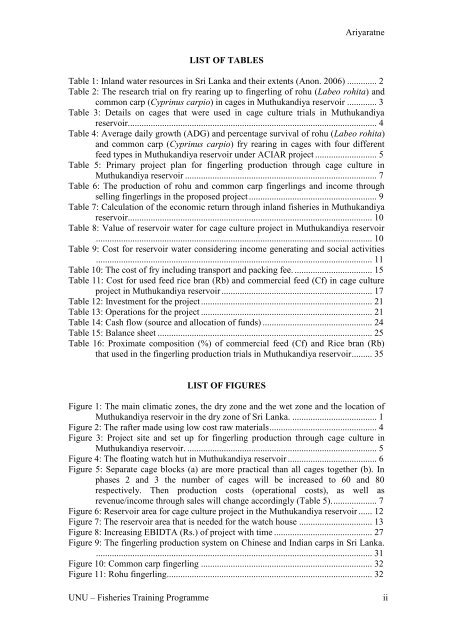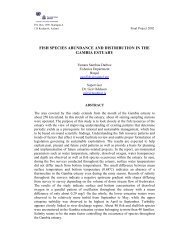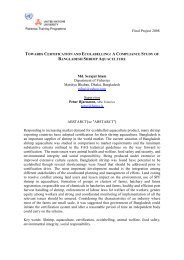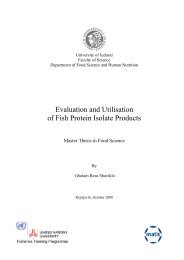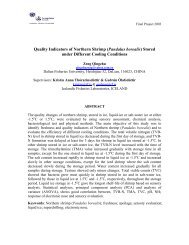Economical basis for fingerling production in cage culture in Sri Lanka
Economical basis for fingerling production in cage culture in Sri Lanka
Economical basis for fingerling production in cage culture in Sri Lanka
You also want an ePaper? Increase the reach of your titles
YUMPU automatically turns print PDFs into web optimized ePapers that Google loves.
AriyaratneLIST OF TABLESTable 1: Inland water resources <strong>in</strong> <strong>Sri</strong> <strong>Lanka</strong> and their extents (Anon. 2006) ............. 2Table 2: The research trial on fry rear<strong>in</strong>g up to <strong>f<strong>in</strong>gerl<strong>in</strong>g</strong> of rohu (Labeo rohita) andcommon carp (Cypr<strong>in</strong>us carpio) <strong>in</strong> <strong>cage</strong>s <strong>in</strong> Muthukandiya reservoir ............. 3Table 3: Details on <strong>cage</strong>s that were used <strong>in</strong> <strong>cage</strong> <strong>culture</strong> trials <strong>in</strong> Muthukandiyareservoir. ............................................................................................................ 4Table 4: Average daily growth (ADG) and percentage survival of rohu (Labeo rohita)and common carp (Cypr<strong>in</strong>us carpio) fry rear<strong>in</strong>g <strong>in</strong> <strong>cage</strong>s with four differentfeed types <strong>in</strong> Muthukandiya reservoir under ACIAR project ........................... 5Table 5: Primary project plan <strong>for</strong> <strong>f<strong>in</strong>gerl<strong>in</strong>g</strong> <strong>production</strong> through <strong>cage</strong> <strong>culture</strong> <strong>in</strong>Muthukandiya reservoir .................................................................................... 7Table 6: The <strong>production</strong> of rohu and common carp <strong>f<strong>in</strong>gerl<strong>in</strong>g</strong>s and <strong>in</strong>come throughsell<strong>in</strong>g <strong>f<strong>in</strong>gerl<strong>in</strong>g</strong>s <strong>in</strong> the proposed project ........................................................ 9Table 7: Calculation of the economic return through <strong>in</strong>land fisheries <strong>in</strong> Muthukandiyareservoir ........................................................................................................... 10Table 8: Value of reservoir water <strong>for</strong> <strong>cage</strong> <strong>culture</strong> project <strong>in</strong> Muthukandiya reservoir......................................................................................................................... 10Table 9: Cost <strong>for</strong> reservoir water consider<strong>in</strong>g <strong>in</strong>come generat<strong>in</strong>g and social activities......................................................................................................................... 11Table 10: The cost of fry <strong>in</strong>clud<strong>in</strong>g transport and pack<strong>in</strong>g fee. .................................. 15Table 11: Cost <strong>for</strong> used feed rice bran (Rb) and commercial feed (Cf) <strong>in</strong> <strong>cage</strong> <strong>culture</strong>project <strong>in</strong> Muthukandiya reservoir .................................................................. 17Table 12: Investment <strong>for</strong> the project ........................................................................... 21Table 13: Operations <strong>for</strong> the project ........................................................................... 21Table 14: Cash flow (source and allocation of funds) ................................................ 24Table 15: Balance sheet .............................................................................................. 25Table 16: Proximate composition (%) of commercial feed (Cf) and Rice bran (Rb)that used <strong>in</strong> the <strong>f<strong>in</strong>gerl<strong>in</strong>g</strong> <strong>production</strong> trials <strong>in</strong> Muthukandiya reservoir ......... 35LIST OF FIGURESFigure 1: The ma<strong>in</strong> climatic zones, the dry zone and the wet zone and the location ofMuthukandiya reservoir <strong>in</strong> the dry zone of <strong>Sri</strong> <strong>Lanka</strong>. ..................................... 1Figure 2: The rafter made us<strong>in</strong>g low cost raw materials ............................................... 4Figure 3: Project site and set up <strong>for</strong> <strong>f<strong>in</strong>gerl<strong>in</strong>g</strong> <strong>production</strong> through <strong>cage</strong> <strong>culture</strong> <strong>in</strong>Muthukandiya reservoir. ................................................................................... 5Figure 4: The float<strong>in</strong>g watch hut <strong>in</strong> Muthukandiya reservoir ....................................... 6Figure 5: Separate <strong>cage</strong> blocks (a) are more practical than all <strong>cage</strong>s together (b). Inphases 2 and 3 the number of <strong>cage</strong>s will be <strong>in</strong>creased to 60 and 80respectively. Then <strong>production</strong> costs (operational costs), as well asrevenue/<strong>in</strong>come through sales will change accord<strong>in</strong>gly (Table 5). ................... 7Figure 6: Reservoir area <strong>for</strong> <strong>cage</strong> <strong>culture</strong> project <strong>in</strong> the Muthukandiya reservoir ...... 12Figure 7: The reservoir area that is needed <strong>for</strong> the watch house ................................ 13Figure 8: Increas<strong>in</strong>g EBIDTA (Rs.) of project with time ........................................... 27Figure 9: The <strong>f<strong>in</strong>gerl<strong>in</strong>g</strong> <strong>production</strong> system on Ch<strong>in</strong>ese and Indian carps <strong>in</strong> <strong>Sri</strong> <strong>Lanka</strong>.......................................................................................................................... 31Figure 10: Common carp <strong>f<strong>in</strong>gerl<strong>in</strong>g</strong> ........................................................................... 32Figure 11: Rohu <strong>f<strong>in</strong>gerl<strong>in</strong>g</strong> .......................................................................................... 32UNU – Fisheries Tra<strong>in</strong><strong>in</strong>g Programmeii


